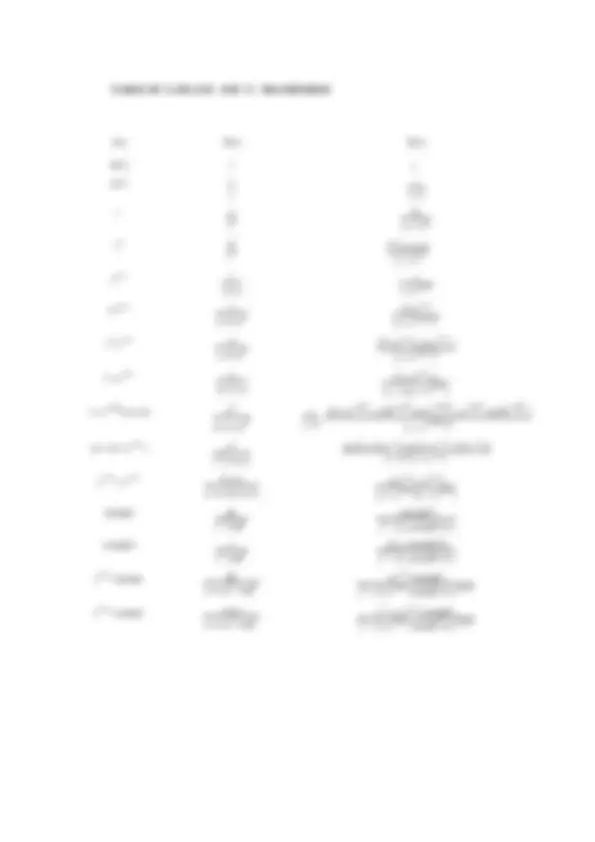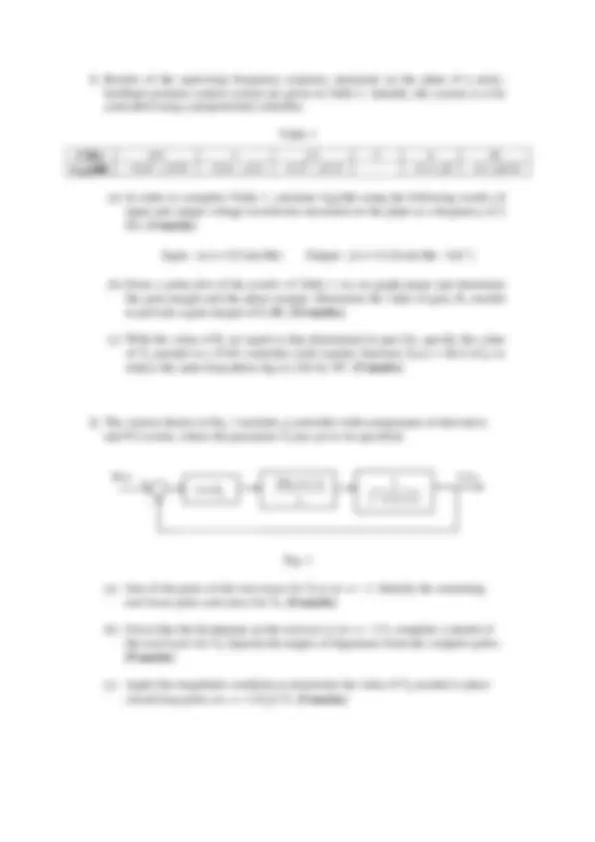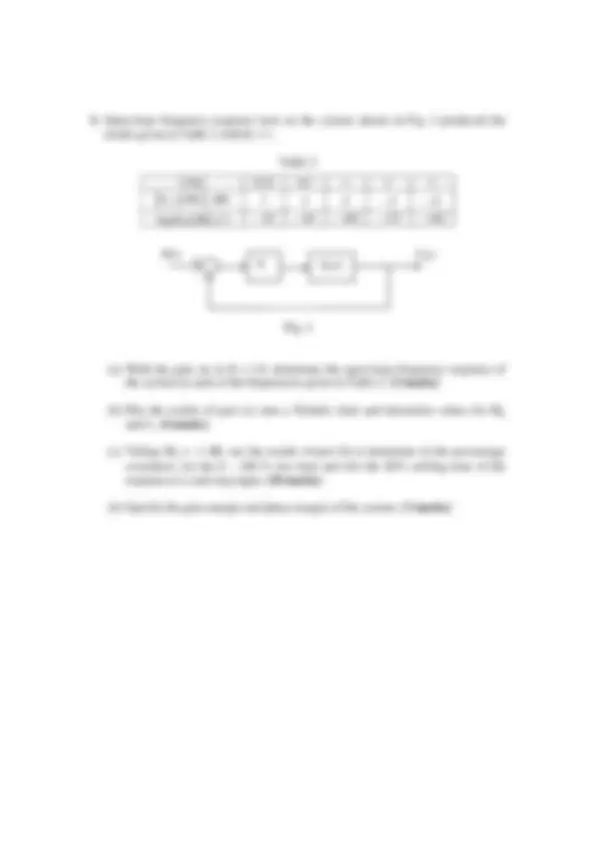Download Polar Plot - Linear Control Systems I - Past Exam Paper and more Exams Linear Control Systems in PDF only on Docsity!
Spring Examinations 2009-
Exam Code(s) 3BN
Exam(s) 3 rd^ Year Electronic Engineering
Module Code(s) EE
Module(s) Linear Control Systems
Paper No. 1
Repeat Paper
External Examiner(s) Prof. G. W. Irwin
Internal Examiner(s) Prof. G. Ó Laighin
Dr. Maeve Duffy
Instructions: Answer five questions from seven.
All questions carry equal marks (20 marks).
Duration 3 hours
No. of Pages 7 including cover
Department(s) Electrical & Electronic Engineering
Course Co-ordinator(s)
Requirements :
MCQ
Handout
Statistical Tables
Graph Paper Yes
Log Graph Paper
Other Material Nichols Chart graph paper
The following standard formulas are given and may be freely used :
Mp Mo^ ^
(^) r (^) n 1 2 (^2) ( 0. 707) (^) d (^) n 1 2
(^) b (^) n (1 2 2 ) (1 2 2 ) 1 Tr ( 0 95 %) 3 / (^) b ( 0. 4)
Tr (0 100%) ^ sin
(^) n 1 (^2) ( 1)
Overshoot 100 exp ^ 1 ^ 2
Ts (2%) (^) ^1 n ln ^ 150 2
^ ( 1)
Ts (5%) (^) ^1 n ln ^ 120 2
^ ( 1)
Ziegler-Nichols Rules : Proportional control : K = 0.5 Kc P+I control : K = 0.45 Kc , Ti = 0.83 Tc PID control: K = 0.6 Kc , Ti = 0.5 Tc , Td = 0.125 Tc
1. Results of the open-loop frequency response measured on the plant of a unity-
feedback position control system are given in Table 1. Initially, the system is to be
controlled using a proportional controller.
Table 1
(a) In order to complete Table 1, calculate Gp(j4) using the following results of
input and output voltage waveforms measured on the plant at a frequency of 2
Hz: [ 3 marks ]
Input: x( t) 0. 5 sin( 4 t) Output: y( t) 0. 16 sin( 4 t 162 o)
(b) Draw a polar plot of the results of Table 1 on cm graph paper and determine
the gain margin and the phase margin. Determine the value of gain, K, needed
to provide a gain margin of 6 dB. [ 12 marks ]
(c) With the value of K set equal to that determined in part (b), specify the value
of Td needed in a P+D controller with transfer function Gc(s) = K(1+sTd) to
reduce the open-loop phase lag at 2 Hz by 30o. [ 5 marks ]
2. The system shown in Fig. 1 includes a controller with components of derivative
and P+I action, where the parameter Td has yet to be specified.
Fig. 1
(a) One of the poles of the root locus for Td is at s = –1. Identify the remaining
root locus poles and zeros for Td. [ 6 marks ]
(b) Given that the breakpoint on the real axis is at s = –3.5, complete a sketch of
the root-locus for Td. Specify the angles of departures from the complex poles.
[ 9 marks ]
(c) Apply the magnitude condition to determine the value of Td needed to place
closed-loop poles at s = 2 j2.72. [ 5 marks ]
f (Hz) 0.5 1 1.5 2 4 10
Gp(j2 f) – 0.49 – j 0.95^ – 0.44 – j 0.4^ – 0.37 – j 0.21^ – 0.2 + j0^ – 0.1 +j0.
_
R(s)
s 2 s 2
10 ( ss 1. 1 ) 2
C(s)
1 sT d
3. Open-loop frequency response tests on the system shown in Fig. 2 produced the
results given in Table 2 with K = 1.
Table 2
Fig. 2
(a) With the gain set at K = 2.8, determine the open-loop frequency response of
the system at each of the frequencies given in Table 2. [ 3 marks ]
(b) Plot the results of part (a) onto a Nichols chart and determine values for Mp
and fr. [ 4 marks ]
(c) Taking Mo = –1 dB, use the results of part (b) to determine (i) the percentage
overshoot, (ii) the 0 – 100 % rise time and (iii) the 2% settling time of the
response to a unit step input. [ 10 marks ]
(d) Specify the gain margin and phase margin of the system. [ 3 marks ]
f (Hz) 0.25 0.5 1 2 3
G p (j 2 f ) (dB) 7 5 0 – 9 – 21
Arg(Gp(j2f)) (o) – 30^ – 60^ – 100^ – 135^ – 160
_
R(s) G C(s)
K p(s)
6. The block diagram of a digital process control system is shown in Fig. 5 for a
sampling interval of T = 0.2 s.
Fig. 5
(a) Write an expression for the system closed-loop z-transfer function, C(z)/R(z).
Determine the locations of the closed-loop poles and zeros, given that there are
complex conjugate poles at z = 0.877 j0.151. [ 7 marks ]
(b) Map the poles and zeros determined in part (a) into the primary strip of the s-
plane. Include a plot of the pole-zero diagram in the s-plane. [ 10 marks ]
(c) Calculate the damping factor associated with the dominant poles in the s-
plane. Give one reason why you would be confident that this value accurately
represents the system response in this case. [ 3 marks ]
7. The settings for an analogue PID controller which was designed according to
Ziegler-Nichols rules are given as: K = 3, Ti = 40 s and Td = 10 s. The controller is
to be replaced with a digital controller.
(a) Taking the frequency of unstable oscillations of the system as a reference,
choose a suitable sampling interval, T. [ 3 marks ]
(b) Apply the bilinear transformation directly to define the z-transfer function of
the digital controller. Write an expression for the recursive control algorithm
to be implemented by a digital processor. [ 11 marks ]
(c) List two differences to be expected between the step responses produced by
the digital controller and the analogue controller. Describe one commonly
used technique used to reduce these differences during digital design
emulation. [ 6 marks ]
_
R(z) C(z)
(z 1 )
1. 2 (z 0. 667 )
(z 0. 8 )(z 0. 6 )
0. 02 (z 0. 8 )














